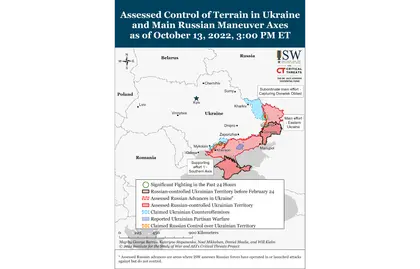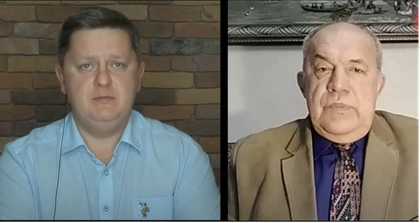Key Takeaways
- Public reports of the first deaths of ill-prepared mobilized Russian troops in Ukraine have sparked renewed criticism of the Russian military command.
- Russian forces continued to launch strikes on critical Ukrainian infrastructure on October 13.
- Increasingly degraded morale, discipline, and combat capabilities among Russian troops in combat zones in Ukraine may be leading to temporary suspensions in offensive operations in limited areas.
- Ukrainian forces made gains northwest of Svatove.
- Russian forces are continuing defensive operations in anticipation of potential Ukrainian attacks towards Kreminna.
- Ukrainian and Russian sources stated that Russian troops are attempting to recapture positions in northern and northwestern Kherson Oblast.
- Damage to the Kerch Strait Bridge continues to impede the movement of Russian supplies and personnel to southern Ukraine.
- Russian forces continued ground attacks in Donetsk Oblast and claimed to make marginal advances south of Bakhmut.
- Russian incompetence continues to take its toll on mobilized personnel before they ever reach the front lines, likely exacerbating already-low morale.
- Russian officials are likely increasingly limiting freedom of movement in Russia to preserve additional mobilizable populations and prevent them from fleeing the country.
- Russian occupation officials called for the evacuation of civilians from occupied Kherson Oblast.
Public reports of the first deaths of ill-prepared mobilized Russian troops in Ukraine have sparked renewed criticism of the Russian military command. Russian media reported that five mobilized men from Chelyabinsk have already died in combat in Ukraine just three weeks after President Vladimir Putin’s declaration of partial mobilization on September 21.[1] The report led many pro-war milbloggers to claim that the number of dead and wounded among mobilized servicemen is likely higher than this due to lack of promised training, equipment, unit cohesion, and commanders, as well as repeated instances of wrongful mobilization.
JOIN US ON TELEGRAM
Follow our coverage of the war on the @Kyivpost_official.
Russian milbloggers claimed that Commander of the 58th Combined Arms Army of the Southern Military District (SMD), Mikhail Zusko, ordered the immediate deployment without any pre-combat training of newly mobilized servicemen of the 15th Regiment of the 27th Motor Rifle Brigade from Moscow City and Moscow Oblast to the collapsing frontline around Svatove around October 2nd and 3rd.[2] Ukrainian outlets had previously reported that the Kremlin has arrested Zusko due to combat losses, and it is unclear why an SMD commander would issue orders pertaining to a unit within the Western Military District (WMD).[3] Milbloggers noted that relatives found half of the 15th Regiment personnel wounded in a Belgorod Oblast hospital after the unit got caught in heavy artillery fire when attempting to reach the Svatove frontline. Milbloggers noted that the regiment had no orders, military command supervision, signal, or supplies, and that the other half of its personnel is still at the Svatove frontline. Another milblogger noted witnessing the coffins of mobilized men arrive in Chelaybinsk, Moscow, and Yekaterenburg, and claimed that many mobilized men are surrendering to Ukrainian forces.[4] One Russian milblogger complained on October 13 that newly mobilized men are being deployed in a haphazard way that will lead to 10,000 deaths and 40,000 injuries among them by February 2023.[5]

Holiday Spirit Thrives Among Ukrainians Despite War, Study Finds
Russian mobilization structures are continuing to face bureaucratic challenges, which may further undermine the combat effectiveness of mobilized personnel. Milbloggers claimed that the Russian Ministry of Defense (MoD) did not set proper conditions to integrate and monitor the deployment of mobilized men at the frontlines.[6] Russian military units reportedly disperse mobilized men among different units without keeping proper records of their deployed locations on the frontlines, causing families to complain to military leadership. Russian military officials are also continuing to assign men with previous military experience to units that do not match their expertise. One milblogger even warned that Russian MoD’s inability to properly update families of the whereabouts of their relatives will lead mothers and wives to form human rights groups that “will break Russia from within.”[7]
ISW cannot independently verify milblogger claims, but the community has been proactive in highlighting the Kremlin’s mobilization since the day of its declaration in hopes of improving the prospects of the Russian war in Ukraine.[8] ISW has also previously reported on a video of mobilized men from Moscow Oblast in Svatove who complained about their lack of equipment and deployment to the frontlines without proper training, which corroborates some milblogger reports.[9] The persistence of such complaints supports ISW’s assessment that the mobilization campaign will not produce enough combat-ready Russian personnel to affect the course of the war in the short term. The Kremlin’s rapid deployment of mobilized servicemen to the Kreminna-Svatove line may also indicate that Russian President Vladimir Putin is willing to throw away the lives of mobilized men in a desperate effort to preserve a collapsing frontline.
The Kremlin continues to struggle to message itself out of the reality of mobilization and military failures. The Kremlin continued its general pattern of temporarily appeasing the nationalist communities by conducting retaliatory missile strikes on Ukraine in an effort to deflect from persistent mobilization problems. Renewed milblogger critiques about mobilization again show how ephemeral the Kremlin’s successes are at deflecting attention from them. The nationalist community resumed its calls on the Kremlin to replace senior officials and commanders and declare war, which some had anticipated would be the Kremlin’s response to the Kerch Strait Bridge explosions, broken mobilization process, and loss of most of Kharkiv Oblast and Lyman.[10] The Kremlin remains trapped in a cycle of appeasing its pro-war constituencies but retaining Russian President Vladimir Putin’s vision of a limited war in Ukraine that is incompatible with their demands and expectations.
Russian forces continued to launch strikes on critical Ukrainian infrastructure on October 13. Ukraine’s Western Air Command noted that Russian forces launched Kalibr cruise missiles at infrastructure in western Ukraine, four of which Ukrainian troops destroyed.[11] The Ukrainian General Staff reported that Russian troops launched missile strikes on critical infrastructure and civilian objects in Kyiv, Dnipropetrovsk, and Mykolaiv Oblasts throughout the day on October 13.[12] Ukrainian military sources also reported that Russian troops continued drone attacks all over Ukraine, and that Ukrainian troops shot down four drones over Vinnytsia and Cherkassy on October 12.[13] Social media footage additionally shows explosions in Rivne, Ternopil, Lviv, Chernivitsi Oblasts following the activation of Ukrainian air defense systems.[14]
Russian forces are likely continuing to use Iranian Shahed-136 drones to support massive strike campaigns against critical Ukrainian infrastructure due to their low efficacy in active combat situations. Ukraine’s Southern Operational Command Spokesperson, Nataliya Humenyuk, claimed on October 13 that Russian forces are employing Shahed-136s primarily to strike buildings and infrastructure because the drones have limited efficacy against troop concentrations.[15] Humenyuk cited various sources who stated that Russia has received between 300 to several thousand Shahed-136s and is using them in areas as far away as 1,000km from the launch point, which is why Shahed-136 use has been densely concentrated around southern Ukraine.[16] Russian forces are also increasingly trying to launch the drones from the northern border area. Humenyuk’s statement, and the pattern of recent Shahed-136 strikes against infrastructure in Ukrainian rear areas, supports ISW’s previous assessment that Shahed-136s will not generate asymmetric effects for Russian forces because they are not being used to strike areas of critical military significance in a way that directly influences the frontline.[17]
Wagner Group financier Yevgeny Prigozhin is likely continuing efforts to distinguish himself and Wagner Group forces from more conventional Russian and proxy troops. Prigozhin emphasized in a comment to Russian outlet RIA FAN that Wagner Group forces singlehandedly took control of Ivanhrad, a settlement just south of Bakhmut, on October 13.[18] However, the Donetsk People’s Republic (DNR) Territorial Defense Force claimed that Luhansk People’s Republic (LNR) and DNR joint forces took control of Ivanhrad and the nearby settlement of Opytne, apparently contradicting Prigozhin’s statement that “not a single person from other units, except for employees of the Wagner Private Military Company” was in Ivanhrad at the time of its capture.[19] Prigozhin additionally rebutted the claim that Russian forces have taken Opytne and stated that fierce fighting is ongoing on its outskirts.[20] The disconnect between Prigozhin’s and the DNR Territorial Defense’s claims, as well as Prigozhin’s apparent desire to have Wagner Group fighters receive sole credit for the capture of Ivanhrad, is consistent with ISW’s previous observations that Prigozhin is jockeying for more prominence against the backdrop of his recent harsh critiques of the Russian Ministry of Defense (MoD) establishment.[21]
Increasingly degraded morale, discipline, and combat capabilities among Russian troops in combat zones in Ukraine may be leading to temporary suspensions in offensive operations in limited areas. The Ukrainian General Staff reported that, particularly in Donetsk Oblast, certain Russian units are receiving orders from commanders to temporarily halt offensive operations due to extremely low morale, psychological conditions, high rates of desertion, and non-execution of combat orders.[22] The General Staff statement is likely a reflection of the fact that Russian detachments are becoming increasingly degraded as they impale themselves on relatively small and insignificant settlements throughout Donetsk Oblast, especially around Bakhmut and the Donetsk City area. As these units become more degraded, they are likely reconstituted ad hoc with disparate combat elements, which leads to further demoralization and incoherence in the conduct of offensive operations. However, the apparent suspension of offensive operations in areas of Donetsk Oblast, nearly the only areas in Ukraine where Russian troops are engaged in offensive operations, will further complicate Russian efforts to take additional territory and likely further contribute to poor morale and overall attrition of combat capabilities.
Authors: Karolina Hird, Kateryna Stepanenko, Katherine Lawlor, and Frederick W. Kagan
You can also highlight the text and press Ctrl + Enter






